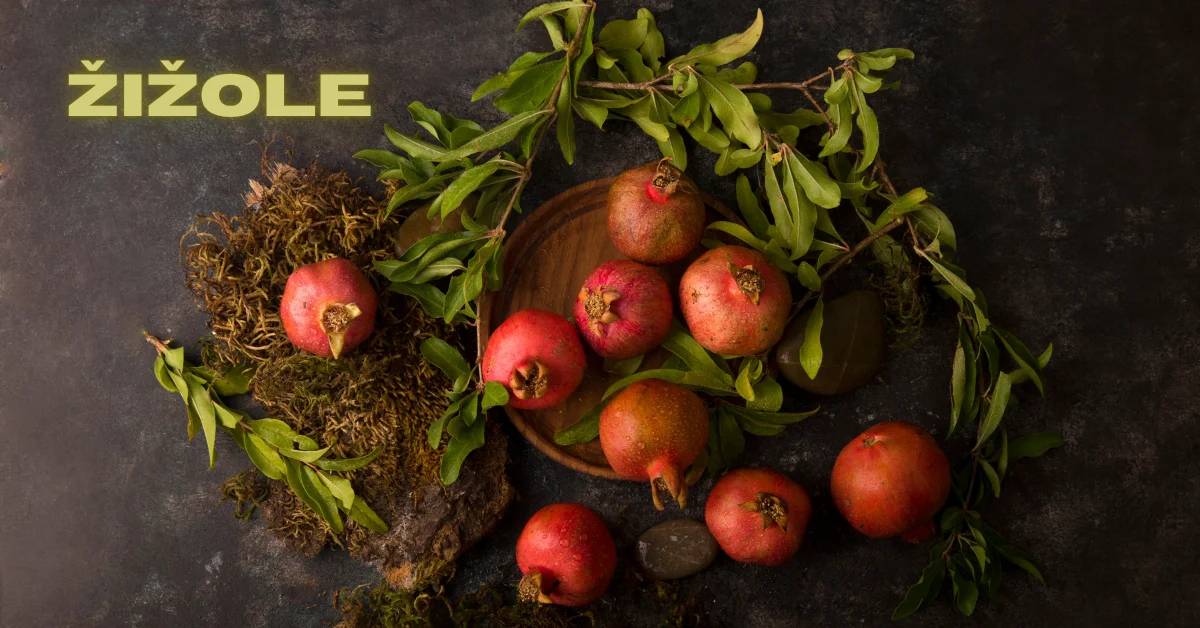Introduction
Nestled in the heart of Mediterranean landscapes and beyond, žižole (Ziziphus jujuba), also known as jujube or Chinese date, is a fruit that’s been cherished for millennia. Originating from China over 4,000 years ago, this small, reddish-brown fruit has found its way into gardens, kitchens, and traditional medicine across the globe, including Slovenia’s Primorska region. Despite its rich history and impressive health benefits, žižole remains a hidden gem for many. In this blog, we’ll explore why this late-autumn fruit deserves a spot in your diet, garden, and cultural adventures.
The Allure of Žižole
Žižole is a small fruit, often compared to olives in shape and dates in flavor, with a sweet-tart taste that’s most pronounced when fully ripened in October or November. When fresh, it has an apple-like crunch; when dried, it becomes chewy and sweeter, reminiscent of dates. This versatility makes it a favorite in both culinary and medicinal applications. In places like Slovenia, particularly in Istria and Primorska, žižole is celebrated not just as a fruit but as a cultural touchstone, woven into local traditions and cuisine.
Nutritional Powerhouse
Žižole is packed with nutrients, making it a superfood in its own right. A 100-gram serving offers about 79 calories, 10 grams of fiber, and a whopping 77% of the daily recommended intake of vitamin C—more than lemons or oranges! It’s also rich in B-complex vitamins, minerals, amino acids, and bioflavonoids. These nutrients contribute to its reputation in traditional Chinese medicine for boosting immunity, improving digestion, and calming the nervous system. Studies suggest žižole may help regulate blood sugar, reduce anxiety, and even inhibit cancer cell growth, thanks to its potent antioxidants like flavonoids and polysaccharides.
- Immune Support: High vitamin C content strengthens the immune system, helping fend off colds and flu.
- Digestive Health: The fiber in žižole aids digestion and alleviates constipation.
- Sleep and Mood: Compounds in žižole seeds act as natural sedatives, promoting restful sleep and reducing anxiety.
- Skin and Heart: Antioxidants protect against oxidative stress, supporting skin health and potentially lowering blood pressure due to its potassium content.
Culinary Versatility
Žižole’s unique flavor makes it a star in the kitchen. Here are some creative ways to enjoy it:
- Fresh or Dried: Eat fresh for a crisp, apple-like snack or dried for a sweet, chewy treat.
- Žižole Tea: Boil dried žižole with ginger and honey for a soothing drink, perfect for cold evenings.
- Baked Goods: Add chopped žižole to muffins, cookies, or bread for a natural sweetness.
- Savory Dishes: In Chinese cuisine, žižole is often added to stews or bone broths for a subtle sweet depth.
- Žižole in Tropinovec: In Slovenia, a popular tradition is soaking žižole in tropinovec (a local spirit) to create a flavorful liqueur. Simply place two handfuls of ripe žižole in a liter of tropinovec, let it sit in the sun for weeks, and optionally add sugar for a sweeter sip.
At local events like the Harvest Fair in Slovenia, you might find žižole pastries, jams, or even brandy, showcasing the fruit’s role in community gatherings.
Growing Your Own Žižole
One of žižole’s greatest strengths is its resilience. This hardy tree or shrub thrives in hot, dry climates and can withstand temperatures as low as -25°C, making it suitable for diverse regions, from Primorska to inland Slovenia. It’s also drought-resistant and requires minimal care, making it ideal for novice gardeners.
- Planting Tips: Plant in well-drained, limestone-rich soil or a cactus soil mix with compost. A sunny spot is key, and while the tree tolerates cold winters, protect young plants from early autumn frosts.
- Growth Options: Grow as a tree (up to 10 meters) or a shrub, or even in a pot for small spaces like terraces.
- Harvest Time: Pick žižole in late summer to early autumn when they turn reddish-brown. For a sweeter taste, wait until the skin wrinkles slightly.
Varieties like Lang, with pear-shaped fruits, are popular for drying and have fewer thorns, making harvesting easier. Unlike some varieties, Lang is often seedless, adding to its appeal.
Cultural Significance
In Slovenia, žižole is more than a fruit—it’s a link to tradition. In Primorska, it’s tied to rituals like the Joninės summer solstice celebration, where bonfires and žižole brandy toasts honor ancient customs. Wedding traditions include sharing žižole wine from a single cup for good luck, and the “spilled drop” ritual—flicking a bit of brandy on the ground—wards off evil spirits. These practices highlight the fruit’s deep roots in local culture.
A Journey Worth Taking
Whether you’re a foodie, a gardener, or a culture enthusiast, žižole offers something special. Visit a Primorska orchard to pick your own, sip žižole-infused tropinovec at a local tavern, or plant a tree in your backyard to enjoy its fruits for years to come. This unassuming fruit carries a legacy of health, flavor, and tradition that’s waiting to be rediscovered.
Conclusion
Žižole may not be a household name, but its nutritional benefits, culinary versatility, and cultural richness make it a fruit worth celebrating. Whether you’re savoring its sweet-tart flavor, brewing a calming tea, or embracing its traditions, žižole invites you to slow down and connect with nature and history. So, next time you’re in a Mediterranean market or planning your garden, give this forgotten superfruit a chance—you won’t be disappointed.
